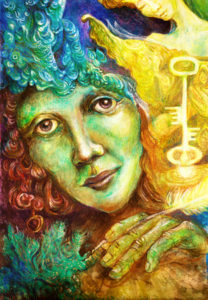
If you pay attention to your dreams you’ve probably noticed that they are not all the same. Some dreams may frighten you, others entertain you, and many probably confuse you. But what you may not know is that all of your dreams have a purpose.
For example, dreams can help you solve problems, decide goals, examine relationships and even foretell the future. With all of this possibility, it’s helpful to start a practice of examining your own dreams so you can utilize the valuable information they offer.
Here are the 12 types of dreams, and their purpose, in order from most commonly occurring, to the least:
Most Common Dream types

Daydreams
One recent Harvard study found that people spend almost half of their waking hours in a daydream. They are the most common form of dreaming in which the dreamer is actually awake, yet consciously detached from immediate reality. The mind wanders beyond the physical, causing the dreamer to appear in a trance-like state as their attention focuses on the inner fantasies of the mind.
Although they may seem like a waste of time or the product of an undisciplined mind, they do serve an important purpose; we daydream to determine the outcome of possible choices for our future, to explore possibility, enjoy reveries and to decide our goals and life direction.
Without the ability to daydream, our thoughts would be confined to the mundane mechanisms of whatever life we happened to be born into. Daydreams are a necessary exercise in imagination, providing inspiration, possibility and mental respite.
Psyche-Dump Dream
A psyche-dump dream is the subconscious mind’s way of cleaning house. These dreams explore your fears, often playing them out to conclusion, which helps to release your waking mind from their harmful grasp.
Although you do not realize it, your subconscious mind is recording everything you experience, including random emotions, fears, unsettling thoughts and possible outcomes that continually flash through your waking mind. If you were not able to process these on some level, your mind would become overloaded, neurotic, or even insane with fear. The purpose of this dream is to clean house, enabling you to keep your sanity and move on from the countless worries that may plague you.
You will recognize this dream as a nonsensical mix of images and occurrences that lack logic. The scenarios and symbols you experience in this dream type often seem random, or have a slight connection to something you experienced in your waking life.
Body Communication Dream
Your body has its own intelligence, as is evident in the way it functions without your conscious direction. Most of the time it is able to take care of itself without your interference, but occasionally it needs a way to let you know that some necessary action is required of you. A body communication dream is one way it delivers this message.
This type of dream is a signal from your body, alerting you to its urgent needs. You experience these when something important is occurring within your body that you must take action to remedy, such as thirst, the need to urinate, or an illness that needs care.
For instance, you might dream that you are searching for water and cannot find any, only to awaken to an intense thirst. Or maybe you dream that bugs are crawling in your ear, only to find out later that you have an ear infection. If you learn to recognize these dreams and act on them, you can utilize their purpose of maintaining health, and even avoid potential illness, throughout your life.

Nightmares
Nightmares present themselves as terrifying stories that upset or frighten you, causing you to awaken in a state of panic or dread. They tend to occur most often when you are in a period of stress, change, illness, denial, or experiencing difficult emotions in your waking life.
Nightmares are direct communications from your subconscious mind to your waking mind, alerting you to potential issues you need to work-out, stress and fears you need to release, or detrimental choices you may be making. They are not meant to be interpreted literally, only to pack a potent punch to alert you to something that needs to be addressed.
The subconscious mind knows the power that fear has on the conscious mind, and so it uses fear to deliver a message that the waking mind cannot ignore. A nightmare will repeat itself in varying forms, potentially building in intensity, until the subconscious is satisfied that its message was received. If you are experiencing nightmares regularly, pay attention to areas of your life that you may have been ignoring, inspect where changes in attitude or action are needed, and seek to make them as soon as possible.
Occasional Dream Types
The following four dream types tend to occur less often for most people, seemingly taking place when the dreamer is on the precipice of change. They are as follows:
Story Dream
Also known as an Epic dream, this one is characterized by its vivid, logical, and memorable expression as a movie-like adventure that stays with you long after awakening. Of all of the dream types, a story dream is perhaps the most pleasurable in terms of entertainment and residual, uplifting after-effects.
Story dreams can invoke strong emotions, transplant you into alternate reality, and leave you with a sense of awe, inspiration, and often a new perspective. Both enchanting and thought-provoking, they serve as a reminder of your imaginative, creative nature and infinite potential.
The purpose of a story dream is to open your mind to the amazing adventure your waking-life can be. If you have one, write it down and contemplate it, allowing the feelings it conveys to blend into your everyday existence. This will allow the dream to serve its purpose of inciting inspiration within you, in order that you will discover new dreams to dream, new paths to take, and more possibilities to explore in life.
Problem-Solving Dream
A problem solving dream can present itself in one of two ways. The first and most common is a logical and vivid dream that utilizes imagery to deliver an answer to a problem you have been struggling with in your waking life. The other is as a lucid-type dream, where you actively work through and solve a problem while dreaming, waking with the vivid memory of the solution you were seeking.
Although remarkable in its indication of our membership as a portion of a higher intelligence, the point of this dream is self-explanatory. If you are working through a seemingly unsolvable issue in your daily life, try going to sleep with the intention of receiving the answer in your dreams, as this is said to induce aid from your subconscious.
There are many excellent examples of the utilization of this dreams type. Visionaries such as Thomas Edison and Albert Einstein, among others, had problem-solving dreams that led to some of histories most astounding discoveries. If you would like to learn more, check out the research in the reference links below.
Progressive Dream
In a progressive dream, the dreamer will have the same dream, in a logical order, within consecutive sleep periods. Each dream builds upon the last in detail and context.
Progressive dreams are similar to problem-solving dreams in that they are meant to lead the dreamer to a certain solution or realization. Progressive dreams also help one explore optional paths to take, or opportunities to reach for, in waking life.
Progressive dreams are direct communications from one’s higher consciousness. Road maps for the soul, they are meant to deliver a solution to a life issue the dreamer has been seeking, or to send the dreamer on a path otherwise left unexplored if not for the guidance of the dream.
If you have progressive dreams, write them down, ponder the guidance being offered to you, and allow the message to guide your waking life choices. If you are able to trust and follow this guidance, you will most likely find yourself in a much better situation than you would have been without these dreams to guide you.
Recurring Dream
This dream type is similar to a nightmare in that it is a direct message from the subconscious mind, and similar to the problem-solving dream in that it is leading you to a solution, or to a specific and beneficial path to take in life. The main difference is that a recurring dream is referring to something that has been a long-term issue, whereas a problem-solving dream offers solutions to specific puzzles you struggle with.
For example, recurring dreams often point to areas of emotional trauma that need to be healed, bad habits that need culling, and/or psychological misgivings that are detrimental to one’s well-being. The point is to gently guide you to finally solve an issue, or let go of trauma, that you have been holding on to for too long.
If you can decipher them, you will find that recurring dreams are working to free you from some sort of painful baggage which no longer serves you. If you have a series of recurring dreams, pay attention to them and seek to recognize what they are suggesting you need to heal.

Infrequent Dream types
The following dream types are the least common. You may never experience some of these, or maybe you are one of the rare few who regularly experiences them all. They do seem to be more common to those who pursue the boundaries of the mind, such as through pray, meditation, and various esoteric practices. The common purpose of all four is a lofty one – to remind the dreamer of the interconnection to all things, seen and unseen.See if you have ever had one of the following four:
Shared Dream
Also known as a mutual dream, a shared dream is one in which two or more people experience the same dream at roughly the same time. The shared dream is usually discovered by chance, when those involved recount a dream they had to others, only to find that there are similarities in dream context among them.
Shared dreams are characterized by their vivid and remarkable context. They can also be labeled as any other dream type, such as a lucid, prophetic or recurring dream. However, they are always remarkable to the dreamer, which is what makes them more likely to share the dream with others.
If you have the same dream as another person, pay attention not only to the meaning and message the dream is reaching to convey to you, but also to the relationship you have with the person whom you share the dream with. There is often a link, be it karmic, past-life, familial or otherwise, that is being drawn to your attention by the dream for a purpose. Each case of shared dreaming is different, therefore it is up to the dreamers involved to decide the meaning of the link, the dream message, and what it means to each individual.
Visitatio n Dream
n Dream
A visitation dream is one in which the dreamer is visited by a departed person. Vivid and life-like, the dream will usually contain a message from, or conversation with, someone who has passed.
The purpose of this dream type is to convey a message to the living from the deceased – usually one of love, reassurance, or forgiveness. Occasionally the deceased will deliver an important message about some aspect of life, such as clues to the whereabouts of important articles, or answers to questions the dreamer may have that only the deceased can provide.
This type of dream is the only one that is usually safe to translate literally. If you have a visitation dream, know that you have truly been visited by the departed, and allow the knowledge of our eternal connections to affect the regard you give to the relationships in your life.
Prophetic Dream
Prophetic dreams are those which foretell future events. There are many examples of these documented throughout history, such as the foretelling of famine in the Old Testament of the Bible via Joseph, or Napoleon’s dream of his own defeat.
This type of dream is thought to be a form of extra-sensory perception (ESP). They are a rare occurrence among any given population, although just how rare is hard to determine given people’s propensity to either misinterpret the language of dreams, or keep odd occurrences such as precognition to themselves to avoid ridicule by an unbelieving, general populace.
A prophetic dream will stand out to the dreamer as a vivid and significant, although it usually doesn’t present as a logical and exact representation of events to come. The language of dreams is symbolic, so the trick to interpreting a prophetic dream is to examine and translate the various symbols and overall mood of the dream.
The purpose of this dream is to help one prepare for upcoming events, as well as to reinforce a new understanding of the connective nature of consciousness, time and reality. Among the many dream types, an actual, prophetic dream is one, if not the most, rare.
Lucid Dream
A lucid dream is one in which the dreamer is aware that they are dreaming. The dream will seem life-like, yet surreal, as the dreamer watches events unfold as if from a third party perspective. The dreamer is also able to influence the dream, enabling them to explore or change the dream landscape in any way they choose, limited only by their imagination.
The lucid dreaming state can be an incredible, mind-opening experience for the dreamer, often with residual effects that blend into waking life such as enhanced intuition, mastering control over the thinking mind, and a boost in creativity.
Because of these benefits, many people have learned to purposefully induce the lucid dreaming state. This is possible through the practice of specific techniques and/or through the ingestion of certain herbal supplements that bring about the lucid state while sleeping. However, lucid dreams are somewhat rare without intentional induction.
The purpose of lucid dreaming is to explore and expand the limitations of ones’ consciousness. If you have a lucid dream, use it to explore an alternate reality in order to push yourself to new limits without risk.
Conclusion
Dreams often seem so puzzling and random to most people that they tend to ignore them. But there is a reason for them. If you work to decipher the language they speak, you will likely find them to be the excellent tool for life navigation, insight and healing they are meant to be.
References:
https://www.famousscientists.org/7-great-examples-of-scientific-discoveries-made-in-dreams/
http://www.therichest.com/rich-list/most-influential/10-amazing-discoveries-made-in-dreams/
http://www.nola.com/health/index.ssf/2010/11/people_daydream_almost_half_th.html
Images:
Unauthorized use and/or duplication of this material without express and written permission from this site’s author and/or owner is strictly prohibited. Excerpts and links may be used, provided that full and clear credit is given to Mechanics of Being with appropriate and specific direction to the original content.

